Bicycling in Northern Italy Part II
Near Vicenza the character of the crops changed once again – less fruit and more vineyards and of the fruit apples predominated. A long traffic jam welcomed me into the city. I was staying in Vicenza’s youth hostel, just a block from Teatro Olimpico – one of Vicenza’s architectural treasures. The hostel had interesting art on the walls, marble steps and a really well equipped professional kitchen. Turned out the owner used to be a chef at the university. However, it was sometimes difficult to find things like plates, knives or glasses. As has been the case since I started this bicycle journey, I was alone in my room. Vicenza is not nearly as popular a destination as Verona and apparently many of the visitors are architecture students. This is because Vicenza was where Palladio, arguably one of the most influential architects of all time, lived and worked in the 16th century. Showing once again how far ahead Italy was, Palladio was the main influence on Thomas Jefferson’s architecture and the US Capitol is built in Palladio’s style, over two hundred years later. The city is placed on the World Heritage List for this reason. Most of Palladio’s buildings are villas outside of town but at least two famous buildings are right in the center – the Teatro Olimpico (along with a theater in Sabbionetta, one of three remaining from the Renaissance) and the Basilica Palladiana.
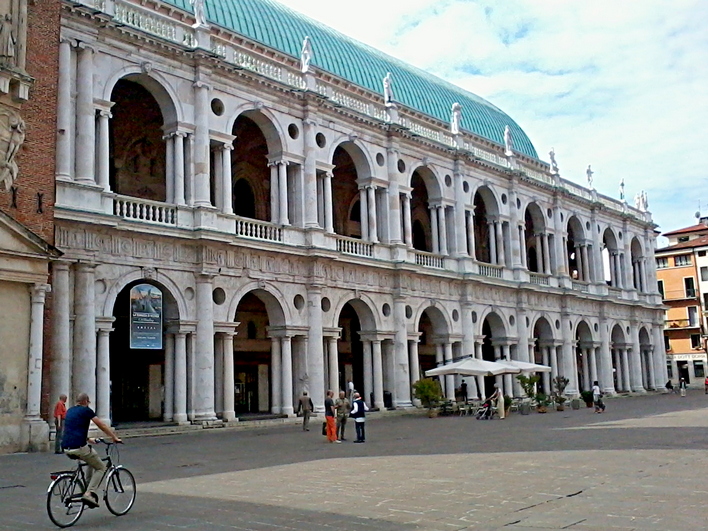
I made a two day stop in Vicenza and did some sight-seeing on the second day. I was lucky to be there on a Saturday when the underground passage that used to be the basement of a Roman mansion is open. It was found fifty years ago during renovation of a church that sits on top of it. But unfortunately flooding damaged the walls and almost nothing of the frescoes remains so it’s mostly just a big U-shaped room underground.
There was another bike tourist at the hostel, from Britain. He was lamenting the rain in Paris and mentioned how they were messing with the weather. I naively asked “The French?” but I should have known he meant the big “they”, or as he put it the “globalists”. According to him global warming was a smoke screen. Though I’m not sure why the globalists would be messing with the weather; it didn’t occur to me to ask. Unfortunately his Internet went out a few days before leaving Britain which he took as a sign that they were onto him and he was on the right track. I don’t want to be too heavy on the guy. Other than being a little awkward and having outlandish theories he was a decent person and we talked about bicycling and travel.

Dolomites
Since I had a whole week until Redentore in Venice and the Dolomites were recommended as a bicycling destination, I decided to turn North. Quite soon after Vicenza the mountains started. My first stop was very close and I reached it before three o’clock just an hour before the rain started. The village, Montepiano, did not have its access road marked on Google maps. The population stood at thirteen – just three families. A few other families split their time and came to stay on weekends. There were 120 people in the village in the 70’s. Montepiano was founded several hundred years ago but was completely destroyed in the first World War as it was just a few miles from the Austrian border. The family who ran the bed and breakfast had a farm where they raised a llama, alpacas, goats and sheep – all for their wool. The were very friendly and I had dinner with them at their house. The bed and breakfast was in a separate building that was just renovated two years ago so everything smelled new and was clean. Though it took half an hour of fiddling with the satellite TV I was able to watch the World Cup final. I watched it alone since I was the only person staying there and I couldn’t even talk to anyone over the Internet – the wi-fi signal from their house was too weak and the wireless modem was slower than dial-up and had a patchy connection. For breakfast I had a fantastic local cheese and the hostess made me some bacon.

The village a little below and further into the valley, though more populated, wasn’t as good a place to live. They were in the shadow of the mountains and got only a few hours of sunlight even in the summer. But it was on the main road and I had to go there for the ATM. After talking to my host – he biked the mountains many times – I revised my route to make it longer and loop around further to the North.
After Montepiano I faced my first serious climb. I had to gain about 700 meters. From there it was a steep descent, so quick that I missed my turn and found myself near Trento, the biggest city in the region. When I got back to my planned route it turned out that the road I picked was a highway. Luckily I had enough map images in my cache that I was able to pick out a new route. I cut through the city and after some meandering found my road which although carrying much traffic at high speed, had a wide shoulder. At the next way point I asked a passing bicyclist the way, which if you know me is a rare thing indeed. In a mix of Italian and English she explained that there was a bicycle path where I was going and instead of trying to explain how to get to it she had me follow her for a kilometer or so to the path. It turned out to be a very nice, paved trail along the Adige river. I found my second wind and got to the town of Salorno before seven.
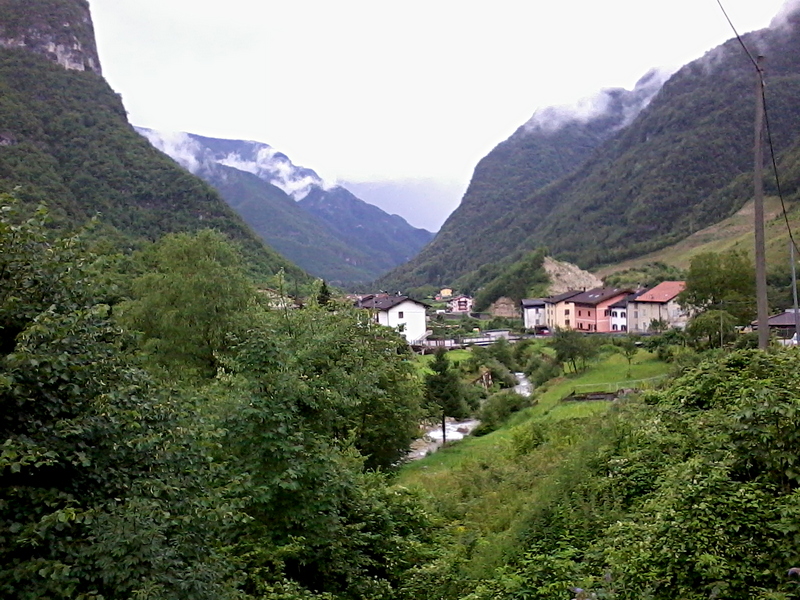
I had no idea there were German speaking parts in Italy and even when I found out, I was sceptical thinking it’s only used at home. But it turned out Salorno had bilingual signs, with German taking precedence, and the hostel clerk addressed me in German. He barely spoke English. Most of the tourists were German. Salorno is along the Via Claudia trail which follows the ancient Roman road and goes all the way into Bavaria. The Italians, despite producing many famous racers and bicycle innovations (the bicycle company Campagnolo is based in Vicenza), prefer the beach to bicycle touring. Not so the Germans. So unlike the Po Valley, Sud Tirol (or Trentino in Italian) had many separated, paved and well marked bike trails.
At Salorno, still hurting from the climb I decided to modify my route again hoping for a little less climbing. I’m not sure if I had achieved that objective. The next day I had to climb another thousand meters and the day after that about the same height again. Luckily during that last day the climb was broken up into two pieces and wasn’t so steep. But my first day out of Salorno had me cursing all the deities. Very soon after the climb started I stopped at an apple stand to get a bottle of juice. The seller turned out to speak very good English because he worked on a cruise line over twenty years ago. He said how American tourists don’t come to the region much anymore because the dollar is so much weaker relative to the Euro than the Italian Lira. Twenty years ago you could buy a good dinner for two for ten dollars, though even in the US you could probably get a decent dinner for ten dollars back then even if only for one person. I asked him if he spoke German too and he replied “If I didn’t speak German here I would die”.
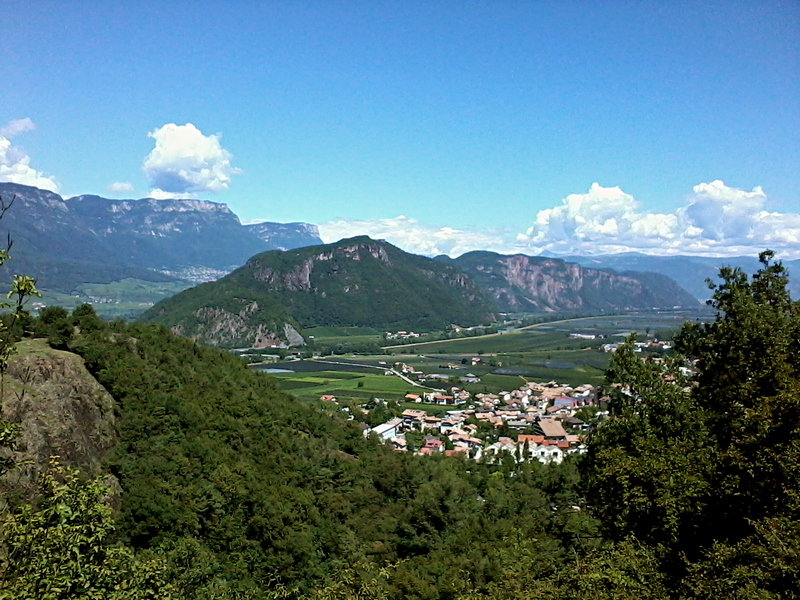
After I reached the Rolle pass it was fifty kilometres down. I passed through closely spaced towns full of vacation houses. In the winter this is a popular skiing destination. Dolomites are considered some of the most beautiful mountains on Earth. They rise very steeply and the contrast between valleys, dark green forests and sheer rock walls capped by clouds is very dramatic.
A little further along I had to pass through many tunnels. One particularly long one had its walls unfaced. It was like being in a cave especially as water dripped from the ceiling. Since it was all downhill I was going pretty fast, probably forty miles an hour at some points. The whistling of the wind combined with the echoing rumbling of cars far behind me. It was hard to tell where they were because the sound carried so far. A mountain stream ran in a gorge far below the road and emptied into a lake.

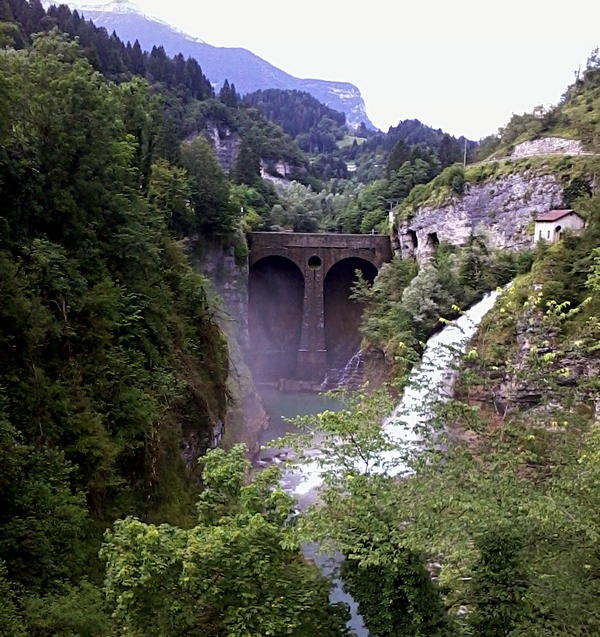
Feltre was my last stop before Belluno where I would meet Marco. it’s your typical small farm town, could be Pennsylvania, except in the middle there’s a fortified old town that is quite charming and well preserved. There wasn’t wi-fi in my bed & breakfast so I went into town. It’s not as common in Italy for cafes to have wi-fi as in the US and I had to hunt around a little. I found a cafe/bar, a pretty common combination, and had an espresso followed by a beer while I talked to my parents via Skype, checked Facebook and watched the locals socialize at the tables outside.
On my last day I only had to go about thirty kilometers if I went straight. But I saw that Cesiomaggiore, a little north of the direct route had a bicycle museum. This turned out to be a good idea because there was a bicycle route there and there was much less traffic and a lot more shade. But there were also a lot of climbs and descents. So it was an effort, especially in the midday heat. Unfortunately the museum is only open on weekends and Wednesdays and it was a Thursday.

Belluno
Approaching Belluno was difficult – the road had no shoulder and there was very heavy traffic. The street that Marco lives on wasn’t on Google Maps but I did find it on Bing Maps. I didn’t know Marco’s address but the street was a short dead end and after looking at names by the door ringers I found his place. His house dates to the 17th century but it was renovated a few years ago and looked nothing like its twin sitting abandoned next to it. A river ran by his house with a walking trail beside it. At the end of a trail was a staircase and on top of that was a bar where we hung out on Friday night. It’s a real neighborhood bar and all kinds of people go there. Though it closed a little early and we moved to bar under the old city gate in the centre.
I took it easy in Belluno, relaxing at Marco’s apartment. It’s a pretty small town with not much to see. It’s more known for its easy access to the mountains than any historic sights. Though one of the biggest sunglasses factories in the world is just outside and since my Ray-Bans carry a “Made in Italy” mark there’s a very good chance they were made there. I made Uzbek plov for Marco and his girlfriend Vanessa but also because I missed homemade food. Lamb is not popular in this region of Italy and is only really eaten on Christmas but I did find some at the butcher’s.
Venice
On Saturday Marco dropped me off at the train station and I got a ticket to Venice. It’s about a two hour ride and I had to switch trains. There used to be a direct train but with every year service seems to be getting worse. Switching trains can be a little tricky in Italy since depending on how you buy your ticket it may not even say what station you need to change trains on. It helps to look up your route on the ticket machines.
A long causeway leads to Venice and it’s strange to be on a train and see water all around you. Then you see buildings rise out of the water. As soon as I left the station I was surrounded by a throng of people. A bachelor party was capering on the bridge across the Grand Canal. I decided to follow Marco’s recommendation and start drinking and not stop until much later. So I went to a supermarket and bought a big bottle of Moretti, the ubiquitous beer here, and a couple sandwiches. I walked around at random and found a big festival. There were many tables set out; people were in line getting quarters of rotisserie chicken; the band stand was empty for now. I used the little fence around a tree to open my bottle, and drank it on a bench watching the people pass by.

I decided to follow the signs for San Marco though I lost the way very soon and came back to where I started. There is no such thing as a straight street in Venice. There are many dead ends often because a canal is in the way but you never know where a street will lead. The names are long and unusual and everything carries one – squares, alleys, under-passages. Trees are rare in Venice and it is a mark of an important building to have some growing around it.
It really did feel magical. It was hard to believe that a city like this exists. Venice is the background, the hometown of Marco Polo in Italo Calvino’s “Invisible Cities”, the only real place in a book filled with imaginary ones.
As I got closer to Rialto I heard sounds of a brass band and followed them to a piazza where they were performing. I am embarrassed to say that I wasn’t sure what Rialto was but it must be important because signs pointed in its direction. I remembered a board game called “Rialto”, set in Venice, but it didn’t really help. After I crossed a big bridge, only the second one I saw across the Grand Canal, the signs stopped and I figured out it was the name of the bridge. It has shops on it but they were closed at this late hour. Darkness was falling. I stopped at a bar playing David Bowie, got another drink in a plastic cup and kept going. From San Marco’s square I found the Grand Canal again. A great crowd of people was gathering by the canal, sitting down. So I figured this must be the place to see the fireworks and found a spot. I met a young woman from Brazil and we talked in English waiting for the fireworks to begin. I asked her to save my spot and went to get another drink. They were quite expensive – 10 euro. By the time I got back the crowd filled the whole wide avenue, from the building wall to the canal and I had to pick my way through. Just before the fireworks I saw points of lights moving quickly through the sky. They were moving too fast to be airplanes but too low and numerous to be satellites. I couldn’t figure out what they were.
The fireworks lasted about forty five minutes. I missed the Independence Day fireworks and this was a fine substitute.
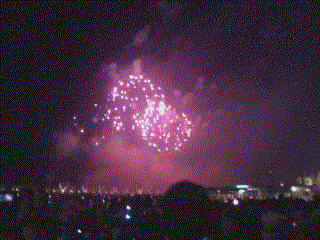
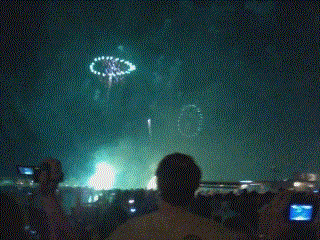


After the fireworks the crowd quickly dispersed. I walked to the other side of the Grand Canal, watched the boats pass by from a bridge, sat on a bench in one of the piazzas. By three o’clock the bars were closed and other than the wide avenue the streets were deserted. I wandered around, following any street that caught my eye. How could I pass by the Street of Miracles? Venice is a flaneur’s paradise. I saw a finely dressed couple leave the casino. It never closes. Isn’t the idea of a casino in Venice already the most ideal casino? To try your fortune in the city of dreams.
Groups of revelers slept on benches, walked on the avenue built on top of what used to be a canal or got snacks at fast food shops. I went all they way back to the train station and turned around, determined to catch the sunrise at San Marco’s square. The square is a great illusion. The repeating pattern of arches and windows confuses the eye and makes it appear smaller. But as you walk through it it keeps receding away, the arches like the bellows of a harmonica.
As it got light I turned back to the station to catch the 6:30 train. The morning light completely confused my bearings and the main avenue that seemed so easy to find in the dark eluded me. I seemed to go in circles but even a circle is too ingenious a shape for Venice. My steps echoed along the empty streets. I kept running into the edge of the city. Finally I found a familiar red fresco and the main avenue. I stumbled onto the train and arrived back in Belluno where I spent the rest of the day recovering.

